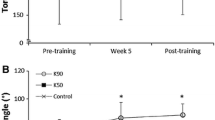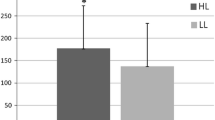Summary
Isokinetic training of right and left quadriceps femoris was undertaken three times per week for 16 weeks. One group of subjects (n=13) trained at an angular velocity of 4.19 rad·s−1 and a second group (n=10) at 1.05 rad·s−1. A control group (n=10) performed no training. Maximal voluntary contraction (MVC) of the quadriceps, and peak pedal velocity (νp,peak) and peak power output (W peak) during all-out cycling (against loads equivalent to 9, 10, 11, 12, 13 and 14% MVC) were assessed before and after training. The two training groups did not differ significantly from each other in their training response to any of the performance variables (P>0.05). No significant difference in MVC was observed for any group after the 16-week period (P=0.167). The post-training increases in averageW peak (7%) and νp,peak (6%) during the cycle tests were each significantly different from the control group response (P=0.018 andP=0.008, respectively). It is concluded that 16 weeks of isokinetic strength training of the knee extensors is able to significantly improve νp,peak andW peak during sprint cycling, an activity which demands considerable involvement of the trained muscle group but with its own distinct pattern of coordination.
Similar content being viewed by others
References
Caiozzo VJ, Perrine JJ, Edgerton VR (1981) Training induced alterations of the in vivo force-velocity relationship of human muscle. J Appl Physiol 51:750–754
Coleman S, Hale T, Hamley EJ (1986) Correct power measurement in the Wingate Test. In: Reilly T, Watkins J, Borms J (eds) Proceedings of the VIII Commonwealth and International Conference, Kinanthropometry III. Spon, London, pp 308–309
Coyle EF, Feiring DC, Rotkis JC, Cote III, Roby FB, Lee W, Wilmore JH (1981) Specificity of power improvements through slow and fast isokinetic training. J Appl Physiol Respir Environ Exerc Physiol 51:1437–1442
Dons B, Bollerup K, Bonde-Petersen F, Hancke S (1979) The effect of weight-lifting exercise related to muscle fiber composition and muscle cross-sectional area in humans. Eur J Appl Physiol 40:95–106
Duchateau J, Hainaut K (1984) Isometric or dynamic training: differential effects on mechanical properties of a human muscle. J Appl Physiol Respir Environ Exerc Physiol 56:296–301
Ewing JL, Wolfe DR, Rogers MA, Amundson ML, Stull GA (1990) Effects of velocity of isokinetic training on strength, power and quadriceps muscle fibre characteristics. Eur J Appl Physiol 61:159–162
Goldberg AL, Etlinger JD, Goldspink DF, Jablecki C (1975) Mechanism of work-induced hypertrophy of skeletal muscle. Med Sci Sports Exerc 7:248–261
Hainaut K, Duchateau J (1989) Muscle fatigue, effects of training and disuse. Muscle Nerve 12:660–669
Hakkinen K, Komi P (1986) Training-induced changes in neuromuscular performance under voluntary and reflex conditions. Eur J Appl Physiol 55:147–155
Jones DA, Rutherford OM, Parker DF (1989) Physiological changes in skeletal muscle as a result of strength training. Q J Exp Physiol 74:233–256
Kanehisa H, Miyashita M (1983) Effect of isometric and isokinetic muscle training on static strength and dynamic power. Eur J Appl Physiol 50:365–371
Komi PV (1986) Training of muscle strength and power. Interaction of neuromotoric, hypertrophic and mechanical factors. Int J Sports Med 7:10–15
MacDougall JD, Ward GR, Sale DG, Sutton JR (1977) Biochemical adaptation of human skeletal muscle to heavy resistance training and immobilisation. J Appl Physiol 43:700–703
Maughan RJ, Watson JS, Weir J (1983) Strength and cross-sectional area of human skeletal muscle. J Physiol (Lond) 338:37–49
McDonagh MJN, Davies CTM (1984) Adaptive response of mammalian skeletal muscle to exercise with high loads. Eur J Appl Physiol 52:139–155
Narici MV, Roi GS, Landoni L, Minetti AE, Cerretelli P (1989) Changes in force, cross-sectional area and neural activation during strength training and detraining of the human quadriceps. Eur J Appl Physiol 59:310–319
Osternig LR (1986) Isokinetic dynamometry: implications for muscle testing and rehabilitation. Exerc Sport Sci Rev 14:45–80
Petersen S, Wessel J, Bagnall K, Wilkins H, Quinney A, Wenger H (1990) Influence of concentric resistance training on concentric and eccentric strength. Arch Phys Med Rehabil 71:101–105
Rösler K, Conley KE, Howald H, Gerber C, Hoppeler H (1986) Specificity of leg power changes to velocities used in bicycle endurance training. J Appl Physiol 61:30–36
Rutherford OM, Jones DA (1986) The role of learning and coordination in strength training. Eur J Appl Physiol 55: 100–105
Rutherford OM, Greig CA, Sargeant AJ, Jones DA (1986) Strength training and power output: transference effects in the human quadriceps muscle. J Sports Sci 4:101–107
Safrit M (1981) Evaluation in physical education, 2nd edn. Prentice Hall, Englewood Cliffs, N. J.
Snedecor GW, Cochran WG (1980) Statistical methods, 7th edn. Iowa Press, Ames, Iowa
Young K, McDonagh MJN, Davies CTM (1985) The effects of two forms of isometric training on the mechanical properties of the triceps surae in man. Pflügers Arch 405:384–388
Author information
Authors and Affiliations
Rights and permissions
About this article
Cite this article
Mannion, A.F., Jakeman, P.M. & Willan, P.L.T. Effects of isokinetic training of the knee extensors on isometric strength and peak power output during cycling. Europ. J. Appl. Physiol. 65, 370–375 (1992). https://doi.org/10.1007/BF00868143
Accepted:
Issue Date:
DOI: https://doi.org/10.1007/BF00868143




